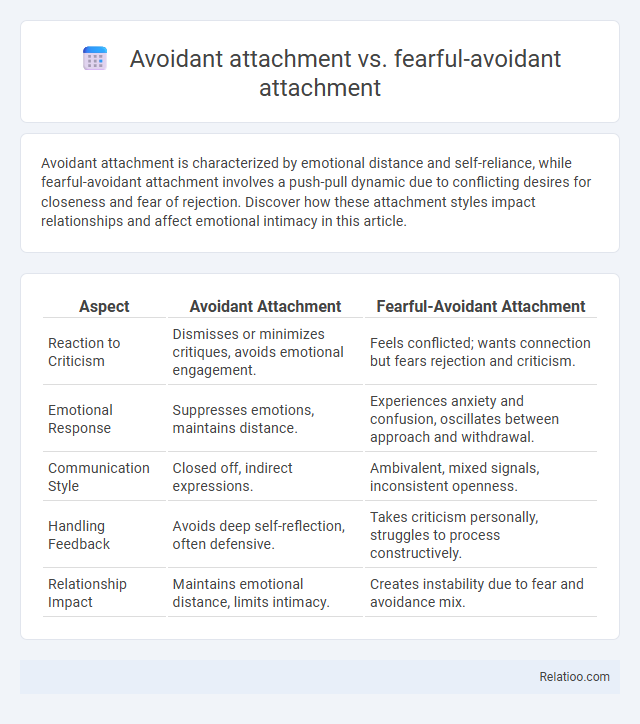Avoidant attachment is characterized by emotional distance and self-reliance, while fearful-avoidant attachment involves a push-pull dynamic due to conflicting desires for closeness and fear of rejection. Discover how these attachment styles impact relationships and affect emotional intimacy in this article.
Table of Comparison
| Aspect | Avoidant Attachment | Fearful-Avoidant Attachment |
|---|---|---|
| Reaction to Criticism | Dismisses or minimizes critiques, avoids emotional engagement. | Feels conflicted; wants connection but fears rejection and criticism. |
| Emotional Response | Suppresses emotions, maintains distance. | Experiences anxiety and confusion, oscillates between approach and withdrawal. |
| Communication Style | Closed off, indirect expressions. | Ambivalent, mixed signals, inconsistent openness. |
| Handling Feedback | Avoids deep self-reflection, often defensive. | Takes criticism personally, struggles to process constructively. |
| Relationship Impact | Maintains emotional distance, limits intimacy. | Creates instability due to fear and avoidance mix. |
Understanding Attachment Styles: An Overview
Avoidant attachment is characterized by emotional distance and a preference for independence, often resulting from early caregiver unresponsiveness, while fearful-avoidant attachment combines a desire for closeness with a fear of intimacy, leading to complex push-pull relationship dynamics. Avoidant attachment typically involves suppression of emotional needs, whereas fearful-avoidant attachment reflects ambivalence and confusion about forming secure bonds. Understanding these distinctions is vital for recognizing how early attachment patterns influence adult relationship behaviors and emotional regulation.
What Is Avoidant Attachment?
Avoidant attachment is characterized by a strong desire for independence and emotional distance in relationships, often stemming from early experiences of neglect or unresponsiveness by caregivers. Fearful-avoidant attachment combines fear of intimacy with avoidant behaviors, resulting in conflicting desires for closeness and rejection, linked to deep-seated trauma or inconsistent caregiving. Understanding avoidant attachment reveals how individuals prioritize self-reliance and suppress emotional expression to maintain control and protect themselves from vulnerability.
What Is Fearful-Avoidant Attachment?
Fearful-avoidant attachment is characterized by a conflicting desire for closeness paired with a fear of intimacy, often stemming from past trauma or inconsistent caregiving. Unlike avoidant attachment, where individuals predominantly distance themselves to maintain independence, fearful-avoidant individuals oscillate between seeking connection and pushing others away due to underlying anxiety and mistrust. This attachment style is linked to emotional dysregulation and challenges in forming stable, secure relationships.
Key Differences Between Avoidant and Fearful-Avoidant Attachment
Avoidant attachment is characterized by emotional distance and discomfort with closeness, leading individuals to prioritize independence and suppress emotional expression. Fearful-avoidant attachment combines a desire for closeness with a deep fear of rejection and abandonment, causing ambivalence and fluctuating behavior in relationships. The key difference lies in Fearful-avoidant individuals' simultaneous yearning for intimacy and fear of getting hurt, whereas Avoidant individuals predominantly maintain emotional detachment to avoid vulnerability.
Common Behaviors in Avoidant Attachment
Avoidant attachment is characterized by a consistent tendency to distance oneself emotionally, exhibiting behaviors such as reluctance to depend on others, suppression of feelings, and discomfort with intimacy. Fearful-avoidant attachment combines avoidance with anxiety, leading to conflicting desires for closeness and fear of rejection, often resulting in erratic relationship patterns. Common behaviors in avoidant attachment include maintaining emotional independence, minimizing vulnerability, and prioritizing self-reliance over emotional connection.
Common Behaviors in Fearful-Avoidant Attachment
Fearful-avoidant attachment is characterized by a paradoxical desire for intimacy coupled with a deep fear of rejection, leading to unpredictable and ambivalent behavior in relationships. Individuals often exhibit difficulty trusting others, emotional withdrawal, and a heightened sensitivity to perceived criticism or abandonment. This attachment style shares similarities with avoidant attachment but is distinguished by underlying anxiety and fear, resulting in alternating approach-avoidance patterns.
Impact of Attachment Styles on Adult Relationships
Avoidant attachment in adults often leads to emotional distancing and difficulty with intimacy, resulting in challenges maintaining close relationships. Fearful-avoidant attachment combines fear of abandonment with discomfort in closeness, causing unpredictable relationship patterns and heightened anxiety. Understanding these attachment styles is crucial for addressing communication barriers and fostering healthier emotional connections in adult relationships.
Origins and Causes of Avoidant vs. Fearful-Avoidant Attachment
Avoidant attachment typically originates from caregivers who are emotionally unavailable or dismissive, leading Your child to develop self-reliance and emotional detachment as coping mechanisms. Fearful-avoidant attachment arises from a combination of inconsistent caregiving and potential trauma, causing conflicting desires for closeness coupled with fear of rejection or harm. Understanding these origins helps differentiate avoidant attachment's primary cause in caregiver neglect from fearful-avoidant attachment's roots in both neglect and abuse or trauma.
Healing and Growth: Addressing Insecure Attachment Styles
Healing avoidant attachment involves building trust and gradually increasing emotional vulnerability to foster secure connections. Fearful-avoidant attachment requires integrating trauma-informed therapy to address underlying fears of abandonment and rejection while promoting self-compassion and relational safety. Growth in avoidant attachment styles centers on consistent emotional awareness practices and supportive relationships that encourage healthy dependency and intimacy.
When to Seek Professional Help for Attachment Issues
Seek professional help for avoidant attachment when persistent emotional distance hinders close relationships and causes significant distress. Fearful-avoidant attachment, characterized by intense conflict between desire for intimacy and fear of rejection, often requires therapy to navigate complex trauma and build secure connections. In cases where avoidant behaviors disrupt daily functioning and emotional well-being, attachment-focused counseling or psychotherapy can provide essential support and coping strategies.

Infographic: Avoidant attachment vs Fearful-avoidant attachment
 relatioo.com
relatioo.com